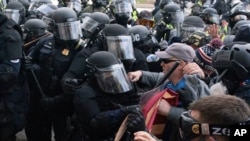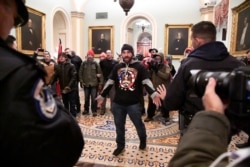While saving lives, Chris Post sometimes feared for his own. During 20 years as a paramedic, he was assaulted and had weapons brandished on him. He learned how to handle himself in hostile environments, investing in protective equipment and working to de-escalate situations.
About a decade ago, he switched careers, becoming a photojournalist for WFMZ in Bethlehem, Pennsylvania. He expected his new job filming high school sports, Girl Scout cookie sales, and other stories, to be safer. But it hasn’t always been.
With his station’s bold call letters wrapped around his vehicle, Post said he finds himself accosted multiple times a month. Most of the time, it is people yelling, “Fake News.” Recently, a man blocked his car, went to his car window and yelled at and threatened him. The incident was not related to specific coverage. Just being a journalist was enough, he said.
“I’m not preaching that the sky is falling, but you are working in your community where there are people who don’t like you because of your profession,” Post told VOA. “Like it or not, people look at us like we are the enemy.”
Post now teaches colleagues the same strategies he mastered as a paramedic.
“I’m teaching journalists about safety techniques, and it frankly terrifies the hell out of me,” he said.
Attacks increasing
It’s a growth business. Between 2017 and 2020, the number of attacks on journalists in the United States grew more than eight-fold, from 50 to 400, according to U.S. Press Freedom Tracker, a project of the Freedom of the Press Foundation and other media organizations.
Many of those incidents involved reporters caught in the crossfire while covering protests. But journalists are also being specifically targeted by extremist groups who threaten and harass them online or add their names to online “death lists.”
In Portland, Oregon, conservative writer Andy Ngô was punched by left-wing protesters as he covered a Proud Boys rally in 2019. He identified the protesters as antifa, the far-left political protest movement opposed to fascism and other extreme right-wing ideology.
Numerous other journalists were injured covering racial justice protests last year.
Targeted attacks began to spike around 2015, when mainstream U.S. outlets began reporting on far-right and white supremacy-linked groups supporting Donald Trump’s presidential run in 2016. (A campaign spokesperson told Politico in 2016, “We have never intentionally engaged directly or indirectly with such groups and have no intention of ever doing so.”)
The rise in violence and online harassment goes beyond claims of “liberal media bias” or accusations that media are working to discredit or undermine the conservative agenda.
Observers and federal officials say the risk from these extremist groups remains high. Testifying before Congress on March 2, FBI Director Christopher Wray said domestic terrorism is “metastasizing around the country.”
Reporting on these groups, or even seeking comment, can result in online abuse and threatening messages and calls.
When Luke O’Brien published a story in 2018 revealing the identity of a woman who posted far-right propaganda and Islamophobic content on Twitter to her more than 200,000 followers, he received dozens of threats via phone, email and Twitter. He and his family and colleagues were also “doxed” — an internet-age term for publishing the home addresses and phone numbers of public figures and their relatives.
“I have been threatened by Nazis since my very first story,” said O’Brien, who until March covered political extremism and disinformation for HuffPost. “It really bothers me, getting harassed and having my life threatened thousands of times. But the problem was that I was the stand-in for all journalists who are the target of an anti-democratic movement.”
Rising tensions, declining trust
The wider tension in American politics, with anger directed at health officials imposing pandemic restrictions, police over racial justice, and election officials dealing with false claims of fraud, is reflected in attacks on journalists and a decline in trust of traditional news sources.
Between 2015 and 2020, trust in media fell from 25% to 13% among right-wing respondents in the U.S., according to polling about news habits by the Reuters Institute for the Study of Journalism at the University of Oxford.
This dynamic received wider recognition following the January 6 attack on the U.S. Capitol when supporters of Trump stormed the building trying to block certification of the November vote. Journalists covering the insurrection for The Associated Press, CNN, The Washington Post and The New York Times were attacked, accosted or threatened.
“It’s not an accident that ‘murder the media’ was written on a [U.S. Capitol] door on January 6,” said Viktorya Vilk, director of digital safety and free expression programs at PEN America.
From the fringes to mainstream
Coverage of extremist groups shifted with their move from the fringes to a more visible and vocal position. Feature stories highlighting (and sometimes humanizing) their leaders gave way to more critical and probing assessments after a self-proclaimed neo-Nazi rammed counter-protesters during a white supremacist rally in Charlottesville, Virginia, in 2017, killing a woman.
Media organizations recognized the need to have reporters cover white supremacy or the far-right as a beat. Investigations of figures who publicly identify with or promote far-right views not only led to death threats against the reporters but a general sense that mainstream outlets might not be as easily gulled.
“In 2015 and 2016, they viewed reporters as someone stupid they could exploit,” said Michael Edison Hayden, senior investigative reporter for the Southern Poverty Law Center, which tracks hate groups. “After the reporting became more effective, reporters became threats.”
Those threats have become more tangible.
While not directly driven by an extremist agenda, two separate attacks on the media in 2018 highlighted the more dangerous environment.
On June 28, a gunman who had unsuccessfully sued the Capital Gazette for defamation killed five employees at the newspaper in Annapolis, Maryland.
He pleaded guilty but said he could not be held responsible because of his mental state at the time. Four months later, a strip club bouncer in West Palm Beach, Florida, mailed pipe bombs to several Democrats critical of Trump, and to CNN. He was sentenced to 20 years in prison.
Those events had a galvanizing effect among extremist groups angry at the media, Hayden said. “People got a taste for blood. A lot of people were saying, ‘Let’s target people online,’ reporters they wanted to get rid of. I was among those.”
Groups at both ends of the political spectrum have been involved in attacks on the media, but more often, the physical threats come from those on the far-right.
“The left-wing tends to target property, and the right-wing tends to target human beings,” said Kelly Kenoyer, an Oregon journalist.
Kenoyer said someone anonymously dropped off neo-Nazi propaganda after she tried to interview a man who had been jailed for an attack on a synagogue, as part of a 2017 feature on fascist and antifascist movements. Several videos were also posted online attacking her. One showed copies of the Eugene Weekly, her paper in Oregon at the time, being burned.
Attempts by journalists to seek comment for stories can result in them being accused of harassing, stalking or doxing. Extremists often do the doxing, unleashing swarms of followers who deluge journalists with hate mail or threats.
Despite an increase of incidents, newsroom culture has not changed much. Receiving hate mail has become an occupational hazard for reporters, so editors and law enforcement officials often tell them to shrug off threats, even when the threats are highly specific.
Reporters covering international terror groups receive support from managers, but those writing about a domestic terrorist who might be in the same city do not always get the same treatment.
Large media outlets accustomed to offering protective equipment and bodyguards to their international correspondents are also investing more in security for domestic coverage. But they are outliers.
“The threats and risks are ramping up,” PEN America’s Vilk said, “but with the decline in resources in the industry, training and security have been going down.”
A fair amount of coverage of the far-right is done by freelancers, who receive little to no support from news organizations. Some support their work by tapping crowdfunding sites, endangering themselves by attempting to capture viral video of heated confrontations and violence.
When it comes to confronting extremist violence, even full-time staff journalists are sometimes left to fend for themselves.
“You’re going to have to develop some best practices to implement on your own,” O’Brien said. “I’ll be honest with you. If you don’t work at a place like The New York Times or The Washington Post, you’re [expletive].”












